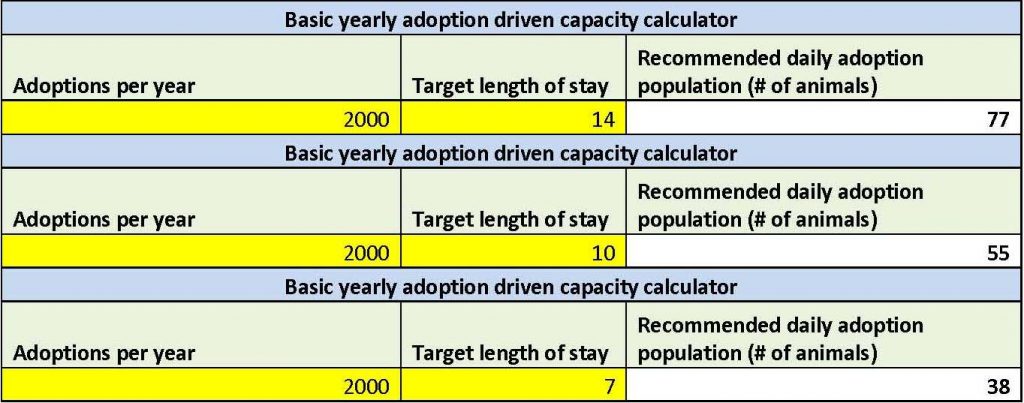Module 6: The Case of the Overwhelmed Shelter
Adoption-Driven Capacity
What is the perfect number of animals to have up for adoption at any one time? How do you know if there are too many or too few?
The UC-Davis Koret Shelter Medicine Program has developed a concept called Adoption-Driven Capacity to answer this question. Simply put, Adoption-Driven Capacity (ADC) is the number of animals to offer for adoption that will promote their adoption chances in the shortest amount of time possible. The number of animals available for adoption will directly impact the likelihood of adoption for each one – the higher the number available, the lower the adoption probability for each animal. By extension, the lower the adoption probability, the longer the average LOS in adoption for each animal. If 10 animals are waiting at any given time for adoption and 1 is adopted each day, the odds of adoption for each animal will be 1 in 10 and the average length of stay to adoption will be 10 days. If 20 animals are waiting at any given time for adoption and 1 is adopted each day, the odds of adoption are 1 in 20 and the average LOS will be 20 days. The only way to decrease LOS is to increase the number of adoptions or decrease the number of animals waiting.
The ideal target LOS in adoption (ready to go with all required holding periods and pre-adoption procedures completed) is 7 to 10 days. To stay within capacity for care, the number of animals in adoption on any given day should not exceed the number of appropriate housing units.
The Koret Shelter Medicine Program created the ADC Calculator tool for calculating ADC based on a shelter’s average number of adoptions per year and a target LOS in adoption.
Download the ADC Calculator tool. Note that there are work tabs at the bottom for calculating Yearly ADC and Monthly ADC. Using the tool, let’s perform some ADC calculations for the following scenarios.
1. The Phil Goode shelter adopts on average 2000 cats per year. Calculate the daily adoption population for target LOS in adoption of 14 days, 10 days, and 7 days.
- Open the Yearly ADC worksheet.
- Go to the Basic Yearly Adoption-Driven Capacity calculator in Rows 5 to 7.
- Enter 2000 in the Adoptions per year cell (Column A/Row 7)
- Enter 14 in the Target length of stay cell (Column B/Row 7).
- The recommended daily population (Column C/Row 7) is 77 animals.
- Repeat the process for a target length of stay of 10 days. The recommended daily population (Column C/Row 7) is 55 animals.
- Repeat the process for a target length of stay of 7 days. The recommended daily population (Column C/Row 7) is 38 animals.

2. The Phil Goode shelter’s cat adoption room contains 55 double-compartment cages appropriate for housing one adult cat each. Review the calculated daily adoption populations for target LOS in adoption of 14 days, 10 days, and 7 days. What should the target LOS be to stay within the adoption housing capacity?
- Based on a housing capacity of 55 cages, the target LOS should be 10 days or less.
3. This shelter would like to increase the annual cat adoptions from 2000 to 2500 next year. To achieve this, what must the target LOS be to stay within the adoption housing capacity of 55?
- In the Yearly ADC worksheet, go to the Reverse calculator for average LOS based on adoptions and daily population in Rows 13 to 15.
- Enter 2500 in the Adoptions per year cell (Column A/Row 15).
- Enter 55 in the Actual daily population cell (Column B/Row 15).
- The target LOS to stay within the adoption housing capacity is in the Average length of stay cell (Column D/Row 15) which is 8 days.

4. For most shelters, kittens are adopted more quickly than adult cats. To increase overall adoptions, the Phil Goode shelter decides to fast track kittens to adoption and put the adult cats on a slow track for adoption. If they do 2500 cat adoptions a year with an overall target LOS of 8 days and 70% of the cats are fast track kittens with a target LOS of 3 days, how many fast track kittens should be available per day? How many slow track adult cats? What is the target LOS for the slow track cats?
- In the Yearly ADC worksheet, go to the Adoption driven capacity calculator: fast track/slow track in Rows 9 to 11.
- Enter 2500 in the Adoptions per year cell (Column A/Row 11).
- Enter 8 in the Overall target LOS cell (Column B/Row 11).
- Enter 3 in the Target LOS: fast track cell (Column C/Row 11)
- Enter 70 in the Percent fast track cell (Column D/Row 11)
- The recommended daily population of cats for fast track is 14 kittens (Column G/Row 11).
- The recommended daily population of cats for slow track is 40 adults (Column H/Row 11).
- The target LOS for adult cats is 20 days (Column E/Row 11).
Note that a daily population of 14 fast track kittens and 40 slow track adult cats is within the adoption housing capacity of 55 cages.


